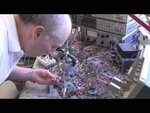c_mitra
Advanced Member level 6
Even a 10 turn air core coil with 10 uH inductance will give a reactance of >600 ohms at 10 MHz which may be very satisfactory for this purpose. They are designed to be lossy (made of the same ferrite powder used for the permanent magnets) and I do not think that the core saturation is a *real* problem. For example, the permeability is most commonly assumed as a constant (we usually refer this quantity as the initial permeability) whereas in reality it is also a complex quantity that depends on the frequency. At high frequency, the dissipation increases, the effective permeability drops (it may drop by a factor of 100 from 1 MHz to 100MHz; rather significant) and the energy stored in the magnetic field cannot be recovered. See, e.g., **broken link removed**
The story can be rather different for hard ferrites that has a wide hysteresis loop but a significant slope even at the saturation point; in other words, they refuse to get saturated. In the intended use of the OP, the bead was supposed to remove noises (in MHz range) in the input signal in the regulator because the regulator simply cannot respond to fast signals and will simply get heated due to dissipation.
The story can be rather different for hard ferrites that has a wide hysteresis loop but a significant slope even at the saturation point; in other words, they refuse to get saturated. In the intended use of the OP, the bead was supposed to remove noises (in MHz range) in the input signal in the regulator because the regulator simply cannot respond to fast signals and will simply get heated due to dissipation.
